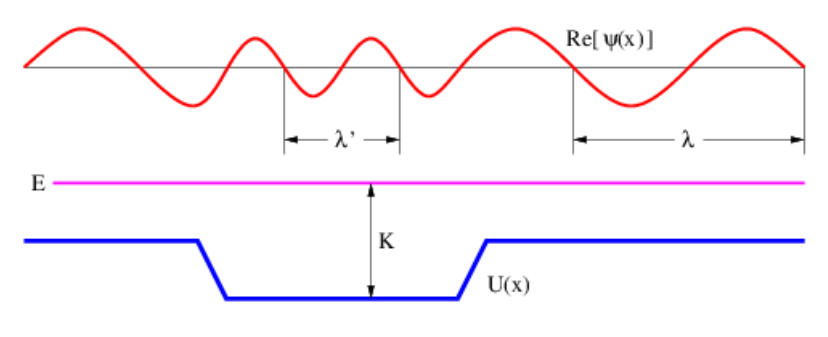9.4: Problems
( \newcommand{\kernel}{\mathrm{null}\,}\)
- Suppose that a particle is represented by the wave function \Psi=\sin (\mathrm{kx}-\omega \mathrm{t})+\sin (-\mathrm{kx}-\omega \mathrm{t}).
- Use trigonometry to simplify this wave function.
- Compute the x and t dependence of the probability of finding the particle by squaring the wave function.
- Explain what this result says about the time dependence of the probability of finding the particle. Does this make sense?
- Repeat the above problem for a particle represented by the wave function \Psi=\exp [\mathrm{i}(\mathrm{kx}-\omega \mathrm{t})]+\exp [\mathrm{i}(-\mathrm{kx}-\omega \mathrm{t})].
- Determine if the wavefunction \psi(x)=\exp \left(i C x^{2}\right) is invariant under displacement in the sense that the displaced wave function differs from the original wave function by just a phase factor.
- Just as invariance under the substitution x \rightarrow x+D is associated with momentum, invariance under the substitution x \rightarrow-x is associated with a quantum mechanical variable called parity, denoted P. However, unlike momentum, which can take on any numerical value, parity can take on only two possible values, \pm 1. The parity of a wave function \Psi(x) \text { is }+1 \text { if } \Psi(-x)=\psi(x), while the parity is -1 \text { if } \Psi(-\mathrm{x})=-\Psi(\mathrm{x}) . \text { If } \Psi(\mathrm{x}) satisfies neither of these conditions, then it has no definite value of parity.
- What is the parity of \Psi=\sin (\mathrm{kx}) ? \text { Of } \Psi=\cos (\mathrm{kx})? The quantity k is a constant.
- Is \psi(x)=\cos (k x) invariant under the substitution x = x + D for all possible values of D? Does this wave function have a definite value of the momentum?
- Show that a wave function with a definite value of the momentum does not have a definite value of parity. Are momentum and parity compatible variables?
- Realizing that \cos (k x-\omega t) can be written in terms of complex exponential functions, give a physical interpretation of the meaning of the above cosine wave function. In particular, what are the possible values of the associated particle’s momentum and energy?
- The time reversal operation T makes the substitution \mathrm{t} \rightarrow-\mathrm{t}. Similar to parity, time reversal can only take on values \pm 1. Is symmetry of a wave function under time reversal, i. e., \text { i. e., } \psi(-t)=\Psi(t), consistent with a definite value of the energy? Hint: Any wave function corresponding to a definite value of energy E must have the form \Psi=A \exp (-\mathrm{iEt} / \hbar) where A is not a function of time t. (Why?)
- The operation C takes the complex conjugate of the wave function, i. e., it makes the substitution \mathrm{i} \rightarrow-\mathrm{i}. In modern quantum mechanics this corresponds to interchanging particles and antiparticles, and is called charge conjugation. What does the combined operation CPT do to a complex plane wave, i. e., one with definite wave vector and frequency?
- Make an energy level diagram for the case of a massless particle in a box.
- Compare |Π| for the ground state of a non-relativistic particle in a box of size a with ΔΠ obtained from the uncertainty principle in this situation. Hint: What should you take for \Delta \mathrm{x}?
- Imagine that a billiard table has an infinitely high rim around it. For this problem assume that \hbar=1 \mathrm{~kg} \mathrm{~m}^{2} \mathrm{~s}^{-1}.
- If the table is 1.5 m long and if the mass of a billiard ball is M = 0.5 kg, what is the billiard ball’s lowest or ground state energy? Hint: Even though the billiard table is two dimensional, treat this as a one-dimensional problem. Also, treat the problem nonrelativistically and ignore the contribution of the rest energy to the total energy.
- The energy required to lift the ball over a rim of height H against gravity is \mathrm{U}=\mathrm{MgH} \text { where } \mathrm{g}=9.8 \mathrm{~m} \mathrm{~s}^{-2}. What rim height makes the gravitational potential energy equal to the ground state energy of the billiard ball calculated above.
- If the rim is actually twice as high as calculated above but is only 0.1 m thick, determine the probability of the ball penetrating the rim.
 Figure \PageIndex{7}:: Real part of the wave function ψ, corresponding to a fixed total energy E, occurring in a region of spatially variable potential energy \mathrm{U}(\mathrm{x}). Notice how the wavelength \lambda changes as the kinetic energy \mathrm{K}=\mathrm{E}-\mathrm{U} changes.
Figure \PageIndex{7}:: Real part of the wave function ψ, corresponding to a fixed total energy E, occurring in a region of spatially variable potential energy \mathrm{U}(\mathrm{x}). Notice how the wavelength \lambda changes as the kinetic energy \mathrm{K}=\mathrm{E}-\mathrm{U} changes.
- The real part of the wave function of a particle with positive energy E passing through a region of negative potential energy is shown in Figure \PageIndex{7}:.
- If the total energy is definitely E, what is the dependence of this wave function on time?
- Is the wave function invariant under displacement in space in this case? Why or why not?
- Does this wave function correspond to a definite value of momentum? Why or why not?
- Is the momentum compatible with the energy in this case? Why or why not?
- Assuming again that \hbar=1 \mathrm{~kg} \mathrm{~m}^{2} \mathrm{~s}^{-1}, what are the possible speeds of a toy train of mass 3 kg running around a circular track of radius 0.8 m?
- If a particle of zero mass sliding around a circular loop of radius R can take on angular momenta \mathrm{L}_{\mathrm{m}}=\mathrm{m} \hbar where m is an integer, what are the possible kinetic energies of the particle? Hint: Remember that \mathrm{L}=\Pi \mathrm{R}.


